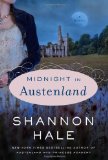
 Midnight in Austenland
Midnight in AustenlandReviewed February 10, 2012.
Bloomsbury, New York, 2012. 277 pages.
Starred Review
2012 Sonderbooks Stand-out: #1 Non-Fantasy Fiction
I'm interrupting my posting of my 2011 Sonderbooks Stand-outs to write a review of a book that will most definitely be a 2012 Sonderbooks Stand-out, if not my favorite book of the whole year.
Shannon Hale's Austenland was a 2007 Sonderbooks Stand-out, though that was the year I was working on my Master's in Library Science and didn't get very many reviews written. The idea is a fun one, playing off all the Jane Austen frenzy that continues to happen in our time. It's about a young woman who goes to what is essentially a Jane Austen theme park in England. Guests come to an English manor and are submerged in Regency culture and finish off their vacation with a ball. The original book parallelled Pride and Prejudice in many ways and was a fun and romantic read.
In Midnight in Austenland, Shannon Hale has surpassed herself.
Now, I should say that this book is particularly delightful to me because this time the heroine is a divorced mom whose husband cheated on her. I definitely related to her and her feelings as she worked through the divorce. She felt like a complete idiot because she hadn't seen the clues that he was cheating, and as the book goes on, it dawns on her just how long he had lied to her. It's very easy to see -- when it's someone else -- that she should not beat herself up for believing someone who vowed to be true to her. But I completely related to all her turmoil about it.
I also loved this book because I am a Jane Austen aficionado. In college, I wrote my English Literature research paper on Jane Austen. I had more than a month to write it -- so I spent the time reading ALL her novels and wrote the paper staying up all night the night before it was due.
Pride and Prejudice is definitely my favorite, but Northanger Abbey is the most light-hearted and just plain fun. Midnight in Austenland parallels Northanger Abbey in so many beautiful ways. In fact, the similarities enhanced the story. You see, Charlotte, our heroine in Midnight in Austenland is playing a "Bloody Murderer" game after the lights go out. In the dark, lit only by a flash of lightning, she is in a secret room and touches a cold hand attached to a covered dead body.
But when Charlotte goes back the next day, there is no body. Did she imagine it in the dark, in the night? In fact, is this book simply paralleling Northanger Abbey, in which silly Catherine Morland imagines a murder has taken place where there was none?
I don't want to say too much more because I don't want to give away any delicious details. I did like that Charlotte has been reading Agatha Christie, so there was still a tribute to novel-reading, as Catherine Morland had been reading The Mysteries of Udolfo. Again, we weren't sure if Charlotte was drawing conclusions because she'd read too many detective novels.
I think I can stay spoiler-free if I simply comment that this book has the best heroine-escapes-from-deadly-peril scene EVER!
In short, Shannon Hale combines lots of humor with Jane Austen parallels, romance, suspense, mystery, gothic themes, and eerie atmosphere in a book that will make divorced women everywhere feel empowered.
You can read Midnight in Austenland without having read Austenland, though I do recommend reading both. The heroines and their stories are different -- they are just at the same theme park with some of the same actors and the same administrator.
To get you in the mood, I'll quote from some of the Prologue, where we're told about Charlotte. It does echo Northanger Abbey:
No one who knew Charlotte Constance Kinder since her youth would suppose her born to be a heroine. She was a practical girl from infancy, only fussing as much as was necessary and exhibiting no alarming opinions. Common wisdom asserts that heroines are born from calamity, and yet our Charlotte's early life was pretty standard. Not only did her parents avoid fatal accidents, but they also never locked her up in a hidden attic room....
We may never know what turned once-nice James away. Was it the fact that his wife was making more money than he was? (A lot more.) Or that his wife had turned out to be clever? (That can be inconvenient.) Had Charlotte changed? Had James? Was marriage just too hard to maintain in this crazy, shifting world?
Charlotte hadn't thought so. But then, Charlotte had been wrong before.
She was wrong when she assumed her husband's late nights were work-related. She was wrong when she blamed his increasingly sullen behavior on an iron deficiency. She was wrong when she believed the coldness in their bed could be fixed with flannel sheets.
Poor Charlotte. So nice, so clever, so wrong.
Charlotte came to believe that no single action kills a marriage. From the moment it begins to stumble, there are a thousand shots at changing course, and she had invested her whole soul in each of those second chances, which failed anyway. It was like being caught in her own personal Groundhog Day, only without the delightful Bill Murray to make her laugh. She would wake up, marvel anew at the bone-crushing weight in her chest, dress in her best clothes, as if for war, and set out with a blazing hope that today would be different. Today James would remember he loved her and come home to the family. Today she would win back her marriage, and her life.
Eventually the time came when Charlotte sat in the messy ruins of her marriage and felt as weak as a cooked noodle. She would never be nice or clever enough. Hope had been beaten to death. She dried her eyes, shut down her heart, and plunged herself into an emotion coma. So much easier not to feel.
Once numbness shuts down a damaged heart, a miracle is required to restart it. Things would prove rough for our heroine. Her only hope was Jane Austen.
